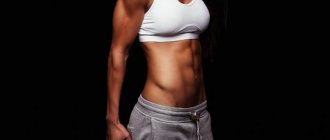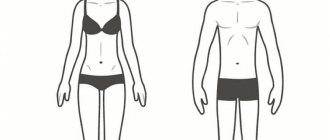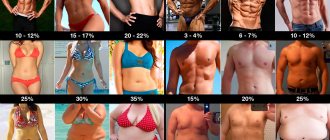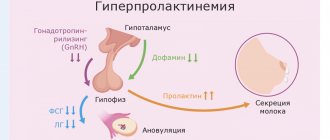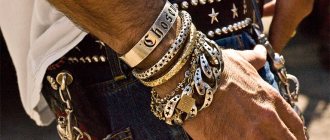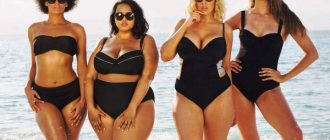- July 21, 2018
- Health
- Ksenia Leonidova
When a person wants to describe someone's figure, they most often use one of three definitions: thin, normal, plump. Everyone has their own idea of the difference between these characteristics: someone may think one person is thin, while someone will say that he is quite normal. Of course, everyone’s concept of beauty is different, but there are also scientific studies that have described human body types for quite some time, and, as they say, you can’t argue with science. Scientists distinguish three body types: asthenic, normosthenic, hypersthenic. Each group has its own pros and cons, knowing which you can build your diet and training in the most constructive way possible. Therefore, before working for results, find out your physical characteristics. You can determine your body type at home. The most common way is to determine body type by wrist. This method was described in 1917 by the domestic doctor G. A. Solovyov. The Solovyov index is a relative indicator of bone thickness, by which you can make a conclusion about your figure. Before answering the question of how to determine your body type by wrist, we list the features of all three body types.
Body types
There are three traditional body types, one of which a person is assigned at birth. Along with it, everyone gets a certain metabolism, the ratio of fat and muscle tissue and the width of bones. Thin-boned, thin people with a high metabolism are asthenics. Proportional, harmoniously developed individuals with medium or wide bones and having an average metabolism are normosthenics. Overweight, big-boned people with a slow metabolism are hypersthenics. Since physique is primarily a classification of the skeleton, one type cannot change into another. People with age (and not only) gain excess weight, but this does not mean that they all become hypersthenics. This only demonstrates that there are some shortcomings in their lifestyle and habits, or indicates other processes occurring in the body.
How to determine your body type based on your wrist?
To determine the constitution of the body you need to perform a few simple manipulations:
Option 1. Take a tape measure and measure the circumference of your wrist.
Option 2. If you do not have a centimeter, then you can use thread, tape, etc. and attach the resulting segment to the ruler.
Option 3. The easiest way is to clasp your wrist with the thumb and forefinger of your other hand: if the fingers touch with reserve, then you are asthenic, if without reserve, you are normosthenic, and if they do not touch at all, then you are hypersthenic.
This is how you can easily and simply determine the body type of men and women based on their wrists. The width of the wrist is considered a constant value, independent of the current weight and amount of muscle mass. You need to measure the narrowest part of the wrist. Next, we look at the result obtained and its meaning.
Basic human body types: features of definition and classification
There are 2 common classifications according to which all people are divided into three types:
- The first method of division according to the structural features of the body was developed by William Sheldon, who introduced the world to the following concepts: ectomorphs, mesomorphs and endomorphs.
- The second classification was proposed by Mikhail Vasilyevich Chernorutsky. It is based on the ratio of height, weight and chest circumference and contains 3 somatotypes: asthenics, hypersthenics and normosthenics.
These concepts are similar to each other and almost identical. The first option is more often used to determine the constitution of men. Let's look at each type in more detail.
Indicators
Of course, each person is unique, but numerous studies and measurements have allowed scientists to determine average parameters that can be used as a guide. The table below lists wrist widths for men and women.
| Body type | men | women |
| asthenic | less than 18 cm | less than 15 cm |
| normosthenic | 18-20 cm | 15-17 cm |
| hypersthenic | more than 20 cm | more than 17 cm |
Asthenic body type
As can be seen from the table, if a girl’s wrist is 14 cm, then she is asthenic. People with this body type are also called ectomorphs. These are graceful individuals who have naturally thin bones. It is not difficult to visually identify asthenics; they have:
- narrow shoulders and chest;
- thin long neck;
- relatively short body;
- small breasts;
- angular body contours;
- elongated limbs;
- underdeveloped muscles;
- small amount of subcutaneous fat.
It is believed that ectomorphs are not strong and resilient enough, so physical activity aimed at developing endurance is more suitable for them. If the goal is to gain muscle mass, then cardio exercises should be abandoned in favor of strength exercises. Since the metabolism of ectomorphs is very high, to preserve energy for a long time, it is better for them to eat foods rich in complex or plant carbohydrates, and increase the number of meals to 5-6 times a day. Fortunately for asthenics, fat deposits are practically not formed on their body, but it is also quite difficult to gain muscle mass. However, with the right diet and proper training, ectomorphs can achieve impressive results.
What somatotypes are there?
The theory of somatotypes was described in most detail in 1940 by the American physician William Sheldon. “According to this system, all people are divided according to morphological characteristics into endomorphs, mesomorphs and ectomorphs. Sheldon used measures on a seven-section scale. Depending on the predominance of one or another component, these were the following body types: ectomorph (thin and tall), mesomorph (with a predominance of bones and muscles), endomorph (rounded, with excess fat),” adds Ekaterina Kalinina.
Pure body types are rare, but every person has a certain dominant somatotype. Let's take a closer look at them.
Ectomorph
Another name is asthenic. “People of this type are distinguished by a predominance of longitudinal dimensions, have relatively long limbs, poorly developed muscles, a thin layer of subcutaneous fat and narrow bones,” explains Ekaterina Zhuravleva.
Ectomorphs have a nervous system with increased activity. “These people have an innately fast metabolism, the level of subcutaneous fat is low, so men of this type are not inclined to bodybuilding. If other people easily gain weight with poor nutrition, then until the age of 40, an ectomorph can eat pizza, drink sweet soda and not gain a single gram of fat,” recalls Ekaterina Kalinina.
How to train? It is difficult for such people to gain weight and build muscle mass, but this is what they need. It is extremely important for “fragile” ectomorphs to strengthen their muscle corset, otherwise pain in the back and joints is inevitable, adds Ekaterina Zhuravleva. “To gain muscle mass, they need to take care of their diet and choose the right workout program in the gym.”
It is optimal, of course, to train according to a program compiled for you by a fitness mentor. Is there no such possibility? Try this training plan.
Mesomorph
Or a normosthenic is an “average” person: the length of his limbs and height are average. He gains weight quite easily, but can lose it without much difficulty. “A pure mesomorph is the owner of a strong body with well-defined muscle relief. He has broad shoulders and chest, muscular arms and legs. The amount of subcutaneous fat is minimal. Mesomorphs gain and lose weight relatively easily,” notes Ekaterina Zhuravleva.
How to train. It all depends on your goal. “Strong, active and hardy mesomorphs should first decide on their goal: gaining muscle mass, maintaining body tone, developing endurance, losing weight. The lesson program will depend on this, says Ekaterina Zhuravleva. — If you need to build muscles, then this is strength training; light cardio exercises, swimming, and various types of group training are perfect for tone. Mesomorphs are the lucky ones: they require much less effort to achieve any result.”
Try this ready-made training program for mesomorphs.
Endomorphs
Or hypersthenics. They are usually not tall and have excess fat mass. “The body of classic endomorphs is characterized by a massive bone structure, wide waist and excess fat deposition. Metabolism in endomorphs is slow, strength indicators are low, says Ekaterina Kalinina. — It is believed that the endomorph is the most common body type among European nations. An endomorph's figure is often spherical or pear-shaped because their pelvis is wider than their shoulders. The limbs can be relatively short or, which is less common, long. The head is most often large.”
Endomorphs tend to be overweight and, as a rule, do not like sports and any types of activities.
How to train. “Endomorphs who are prone to obesity, first of all, should be careful about nutrition, otherwise all the efforts in the gym may be in vain,” recalls Ekaterina Zhuravleva. — To minimize the amount of body fat, all training methods should be aimed at accelerating metabolism, which is naturally low in endomorphs. This is possible thanks to cardio and strength training. At the same time, outside the fitness center, endomorphs should also be active: walk more, not use the elevator, etc.”
An example of a ready-made program for endomorphs can be found here.
Normosthenic body type
To the question about what body type girls have with a 15 cm wrist, we answer that it is normasthenic. The figure of mesomorphs, as normosthenics are also called, is the standard figure. Such people are proportional, their genetic potential is enormous: subject to diet and regular exercise, their body quite easily acquires a sporty appearance. Those with wrists of 16 cm and 17 cm are also normosthenics. Characteristics of mesomorphs:
- developed muscles;
- the body and limbs are proportional;
- the shoulders are well developed, the chest is of medium size;
- pronounced waist;
- the fat layer is present, but in moderate quantities throughout the body;
- the skin is elastic, dense.
Normosthenics are distinguished by the fact that they quickly gain weight and lose it just as quickly. The diet of normosthenics should contain equal amounts of proteins and carbohydrates, and fats should not be excluded. Any type of activity is suitable for a mesomorph.
Hypersthenic body type
What is your body type with a wrist of 18 cm or more? That's right, hypersthenic. Another name is endomorphs, they are predisposed to obesity, and slow metabolism makes it difficult to burn subcutaneous fat. Visual characteristics of endomorphs:
- curvaceous;
- wide chest, large breasts;
- voluminous shoulders and hips;
- short limbs;
- heavy bones;
- fat mass predominates over muscle mass;
- loose skin.
For endomorphs, it is best to limit fat intake and increase physical activity. To avoid injuring your joints, exercise in the pool is ideal: swimming or aerobics. Only regular cardio training and a healthy diet can reduce subcutaneous fat in hypersthenics.
Other ways to determine body type
We have looked at how to determine body type by wrist, but there are other ways that will help in this procedure:
- Visual. Quite often, a simple glance at your reflection in the mirror is enough to determine the constitution of your body. In the case when the shoulders, chest, waist and hips are approximately on the same line without significant differences, you are most likely asthenic. If the hips and shoulders (for girls) are on the same line, and the waist is clearly defined, then you are more likely to be normosthenic. A wide waist, full arms, legs and stomach indicate a hypersthenic type of build.
- Along the intercostal angle. For normosthenics this angle is close to 90 degrees, for asthenics the angle is straight, and for hypersthenics it is obtuse.
- Elbow width. To do this, you need to extend your arm in front of you, bend it at the elbow at a right angle, with your fingers pointing upward, your palm open and facing your body. Next, with the thumb and index finger of the other hand, you need to touch the most protruding places of the elbow joint (for the index finger this will be the ulna bone) and measure the resulting distance between the fingers using a ruler. The higher the number, the greater the chance that you are an endomorph.
- Measuring certain parts of the body and subsequent calculation using special formulas. This is the most accurate method that can be done at home or in fitness centers.
- Online calculators that can help you find out your body type.
Determination of the epigastric angle
The epigastric angle is the angle that forms between the 12th pair of ribs (the lowest pair). To determine it, go to the mirror, take a deep breath and hold your breath. Take two pencils and arrange them so that their ends on one side meet at the junction of the lower edges, and the pencils themselves are located along each of the edges. The location of the pencils will clearly show you the size of the intercostal angle. By its value you can determine your body type.
| Body type (somatotype) | The value of the epigastric angle ° |
| Ectomorph | less than 90° |
| Mesomorph | 90° |
| Endomorph | more than 90° |
Celebrities with different body types
To better imagine all three body types, let us give examples of famous personalities who have asthenic, normosthenic and hypersthenic body types.
Star asthenics are Keira Knightley, Victoria Beckham, Ingeborga Dapkunaite, Emma Watson and others.
Popular normosthenics are Sophia Loren, Scarlett Johansson, Kim Kardashian, Halle Berry, etc.
Famous hypersthenics - Ashley Graham, Adele, Anfisa Chekhova, Irina Pegova, etc.
FAQ
What are the body types? Chernorutsky identifies three main body types: asthenic, normosthenic and hypersthenic. Body type is genetically determined, but in childhood, with prolonged exposure to any external factors, the nature of the innate genotype can change.
How to determine your body type? To determine your body type using the Solovyov method, you need to measure the volume of the thinnest part of the wrist with a centimeter. Interpretation of the results: Asthenic type: less than 18 cm in men and less than 15 cm in women Normosthenic type: 18-20 cm in men and 15-17 cm in women Hypersthenic type: more than 20 cm in men and more than 17 cm among women.
What is the best body type? Mesomorph is the best body type, characterized by developed breasts, broad shoulders, medium-sized bones, increased strength, visible muscles and reduced subcutaneous fat.
Share link:
5 / 5 ( 36 votes)
